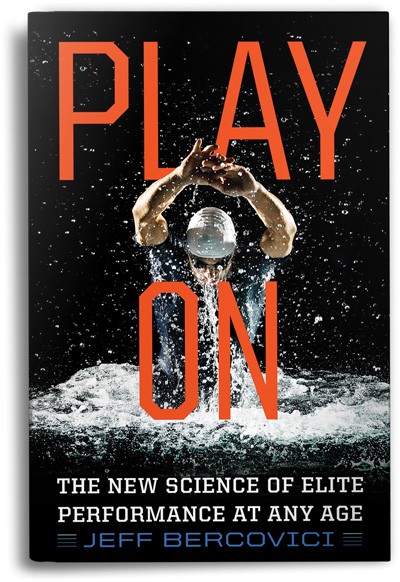Keep Running, Never Get Over the Hill
Elite athletes are now maintaining their level of performance in their 40s and beyond. What can they teach the rest of us?
A s an athlete on the precipice of my 40th birthday, I’ve been dogged by the questions that Jeff Bercovici raises in Play On: The New Science of Elite Performance at Any Age. I bike every day, practice yoga, and run six to eight miles a couple of times a week. Last year I experienced hamstring pulls, calf pulls, Achilles tendon pain, and an ankle injury that drove me to start swimming in order to reduce the load on my aching legs. Does this increasing rate of injury mean that I’m starting a slow decline into senescence? Or does it indicate that I just need to train differently?
Bercovici’s book argues that it’s the latter. In almost every sport, he writes, “athletes are sticking around for an extra victory lap or three, rather than shuffling off to the metaphorical showers at the first sign of gray.” He has ample examples for inspiration. Peyton Manning and Tom Brady were 39 when they became the oldest quarterbacks to win Super Bowls. Cyclist Kristin Armstrong turned 43 in Rio in 2016 and became the first Olympian ever to win gold three times in the same cycling event. Every year, the big-wave surfers at the legendary Mavericks competition get a bit grayer, with half of the top finishers older than 40. Runners of all distances are reaching peaks later in their careers. The trend is most pronounced in tennis, where the average age of tournament winners was 24 in 2006. By 2016, it had jumped to 29, and the number of tournament champions over 30 increased from zero to 14. Serena Williams was 34 when she became the oldest woman ever to win a Grand Slam tournament, and she later revealed that she had been pregnant at the time.
These superheroes work out insanely hard, and they’ve sacrificed much in their lives to maintain lifestyles with optimal nutrition and self-care. They also have coaches and researchers designing their training programs. But in Bercovici’s book, he is the real protagonist. He, too, is nearing 40 and dives into fitness science to figure out whether he can perform at a higher level and avoid injuries while pursuing amateur soccer well into the coming decades.
What he finds is that for any athlete, recovery, rest, and the rhythm of workouts are as important as practicing drills and lifting weights. “We are conditioned to believe that working out equals feeling beat up,” Bercovici writes. But chronic overtraining is what dooms an athlete, he says, and increases the risk of injury and performance decline. While injuries are the unknown factor that athletes obsess over, whether they are avoided is not just a matter of luck or fitness, but a skill that can be learned.

He drives this home with a study of the injury rates of athletes training under different coaches. Coaches who are lighter on training during the season can expect fewer players to be benched by injuries. Genetic testing has revealed differences in DNA that regulate the thickness of ligaments and tendons, so sequencing athlete genomes can reveal who is more prone to sprains and tears. Another recommendation emerges: athletes should sleep as much as possible. Roger Federer and LeBron James aim for 12 hours a night.
Bercovici’s reporting is terrifically engaging and his breakdown of science is approachable. But he leaves out a huge realm of investigation in fitness.
He notes that a half-century ago, a 40-year-old who jogged for exercise or lifted weights at the gym was a novelty. He uses this to support the idea that a significant cultural change has brought acceptance for the older athlete, and therefore higher levels of achievement are now possible. “Peering into the world of elite athletes is literally a glimpse into the future the rest of us will soon be living in,” he predicts. He lays this futurist optimism on especially thick in one chapter about new technologies and wearables that athletes are using to make their workouts smarter. They’re stimulating motor regions of the brain, measuring biomarkers that predict their levels of fatigue, and benefiting from streamlined new materials for shoes and clothes.
Yet as Christopher McDougall described in his 2009 book Born to Run, there are entire indigenous communities made up of people whose physical fitness matches that of elite athletes. They have no coaches, no Spandex, and no high-protein smoothies. But they do rest a lot, eat a lot of protein, and have a lot of low-level physical activity on a daily basis. Recent work conducted by University of Cincinnati anthropologist Jeremy Koster has revealed that hunter-gatherers’ physical decline is very gradual. A 55-year-old has 85 percent of the agility and hunting ability of a 31-year-old. Koster notes that experience might have a lot to do with it, which fits with some of Bercovici’s reporting on the superior mental game of older athletes.
Thus it may be more accurate to say that the world of elite athletes is a reminder of the past that we all used to live in, rather than a glimpse of our future. The science depicted in Play On is recent, but the R&D of evolution goes back millions of years. As I enter my fifth decade, I think it’s wiser to skip the hyperbaric pods and cryosaunas in favor of being active outdoors as much as possible.












